Mesoporous Materials Make Hydrogels More Powerful in Biomedicine
Abstract
1. Introduction
2. Classification of Mesoporous Material-Loaded Composite Hydrogels
2.1. Mesoporous Silicon-Loaded Composite Hydrogels
2.1.1. Mesoporous Silica-Loaded Composite Hydrogels
2.1.2. Mesoporous Bioglass-Loaded Composite Hydrogels
2.2. Mesoporous Non-Silicon-Loaded Composite Hydrogels
3. Crosslinking Methods of Mesoporous Material-Loaded Composite Hydrogels
3.1. Physical Crosslinking Method
3.2. Chemical Crosslinking Method
3.3. Radiation Crosslinking Method
4. Application of Mesoporous Material-Loaded Composite Hydrogels
4.1. Drug Delivery
4.2. Tumor Therapy
4.3. Antibacterial Treatment
4.4. Osteogenesis
4.5. Hemostasis
4.6. Wound Healing and Tissue Regeneration
5. Patents and Clinical Trails
6. Conclusions and Prospect
Author Contributions
Funding
Conflicts of Interest
References
- Mitra, S.; Sharma, V.K.; Mukhopadhyay, R. Diffusion of confined fluids in microporous zeolites and clay materials. Rep. Prog. Phys. 2021, 84, 066501. [Google Scholar] [CrossRef] [PubMed]
- Li, B.; Wang, H.; Chen, B. Microporous metal-organic frameworks for gas separation. Chem.-Asian J. 2014, 9, 1474–1498. [Google Scholar] [CrossRef] [PubMed]
- Takeshita, S.; Zhao, S.; Malfait, W.J.; Koebel, M.M. Chemistry of Chitosan Aerogels: Three-Dimensional Pore Control for Tailored Applications. Angew. Chem. Int. Ed. 2021, 60, 9828–9851. [Google Scholar] [CrossRef]
- Wang, J.; Tang, Y.; Cao, Q.; Zhang, X. Fabrication and biological evaluation of 3D-printed calcium phosphate ceramic scaffolds with distinct macroporous geometries through digital light processing technology. Regen. Biomater. 2022, 9, rbac005. [Google Scholar] [CrossRef] [PubMed]
- Ryoo, R. Birth of a class of nanomaterial. Nature 2019, 575, 40–41. [Google Scholar] [CrossRef] [PubMed]
- Liang, Y. Recent advanced development of metal-loaded mesoporous organosilicas as catalytic nanoreactors. Nanoscale Adv. 2021, 3, 6827–6868. [Google Scholar] [CrossRef] [PubMed]
- Amri, F.; Septiani, N.L.W.; Rezki, M.; Yuliarto, B. Mesoporous TiO2-based architectures as promising sensing materials towards next-generation biosensing applications. J. Mater. Chem. B 2021, 9, 1189–1207. [Google Scholar] [CrossRef]
- Du, L.; Cheng, Z.; Zhu, P.; Tan, K. Preparation of mesoporous silica nanoparticles molecularly imprinted polymer for efficient separation and enrichment of perfluorooctane sulfonate. J. Sep. Sci. 2018, 41, 4363–4369. [Google Scholar] [CrossRef]
- Kazemzadeh, P.; Sayadi, K.; Toolabi, A.; Sargazi, G. Structure-Property Relationship for Different Mesoporous Silica Nanoparticles and its Drug Delivery Applications: A Review. Front. Chem. 2022, 10, 823785. [Google Scholar] [CrossRef]
- Vallet-Regi, M.; Salinas, A.J. Mesoporous bioactive glasses for regenerative medicine. Mater. Today Bio 2021, 11, 100121. [Google Scholar] [CrossRef]
- Cheng, C.; Sun, Q.; Wang, X.; Jiang, T. Enzyme-manipulated hydrogelation of small molecules for biomedical applications. Acta Biomater. 2022, 151, 88–105. [Google Scholar] [CrossRef] [PubMed]
- Yang, J.; Rao, L.; Wang, Y.; Liu, Y. Recent Advances in Smart Hydrogels Prepared by Ionizing Radiation Technology for Biomedical Applications. Polymers 2022, 14, 4377. [Google Scholar] [CrossRef] [PubMed]
- Muya, F.N.; Sunday, C.E.; Baker, P.; Iwuoha, E. Environmental remediation of heavy metal ions from aqueous solution through hydrogel adsorption: A critical review. Water Sci. Technol. 2016, 73, 983–992. [Google Scholar] [CrossRef] [PubMed]
- Murshid, N.; Mouhtady, O.; Abu-Samha, M.; Younes, K. Metal Oxide Hydrogel Composites for Remediation of Dye-Contaminated Wastewater: Principal Component Analysis. Gels 2022, 8, 702. [Google Scholar] [CrossRef] [PubMed]
- Ao, Y.; Tang, W.; Tan, H.; Yang, L. Hydrogel composed of type II collagen, chondroitin sulfate and hyaluronic acid for cartilage tissue engineering. Bio-Medical Mater. Eng. 2022, 33, 515–523. [Google Scholar] [CrossRef] [PubMed]
- Wang, Q.; Qu, Y.; Zhang, Z.; Sun, L. Injectable DNA Hydrogel-Based Local Drug Delivery and Immunotherapy. Gels 2022, 8, 400. [Google Scholar] [CrossRef]
- Rao, K.M.; Rao, K.S.V.K.; Palem, R.R.; Han, S.S. pH Sensitive Drug Delivery Behavior of Palmyra Palm Kernel Hydrogel of Chemotherapeutic Agent. Gels 2023, 9, 38. [Google Scholar] [CrossRef]
- Op’t Veld, R.C.; Walboomers, X.F.; Jansen, J.A.; Wagener, F.A. Design Considerations for Hydrogel Wound Dressings: Strategic and Molecular Advances. Tissue Eng. Part B Rev. 2020, 26, 230–248. [Google Scholar] [CrossRef]
- Jiang, Y.; Krishnan, N.; Heo, J.; Zhang, L. Nanoparticle-hydrogel superstructures for biomedical applications. J. Control. Release 2020, 324, 505–521. [Google Scholar] [CrossRef]
- Kurian, A.G.; Singh, R.K.; Patel, K.D.; Kim, H.W. Multifunctional GelMA platforms with nanomaterials for advanced tissue therapeutics. Bioact. Mater. 2022, 8, 267–295. [Google Scholar] [CrossRef]
- Huang, S.; Hong, X.; Zhao, M.; Guo, R. Nanocomposite hydrogels for biomedical applications. Bioeng. Transl. Med. 2022, 7, e10315. [Google Scholar] [CrossRef] [PubMed]
- Ding, F.; Zhang, L.; Chen, X.; Wang, M. Photothermal nanohybrid hydrogels for biomedical applications. Front. Bioeng. Biotechnol. 2022, 10, 1066617. [Google Scholar] [CrossRef] [PubMed]
- Deng, Z.J.; Zhang, W.Z.; Lu, Y.Z.; Zhang, Y.H.; Lu, Z.M.; Pei, S.J. Fabrication of Hydrogel Beads Entrappted by Mesoporous Silicates Nanoparticles for pH-sensitive and Sustained Release of Indomethacin. Asian J. Chem. 2014, 26, 3609–3614. [Google Scholar] [CrossRef]
- Miyamoto, N.; Shimasaki, K.; Yamamoto, K.; Shintate, M.; Kamachi, Y.; Bastakoti, B.P.; Suzuk, N.; Motokawa, R.; Yamauchi, Y. Mesoporous Silica Particles as Topologically Crosslinking Fillers for Poly(N-isopropylacrylamide) Hydrogels. Chem.-Eur. J. 2014, 20, 14955–14958. [Google Scholar] [CrossRef] [PubMed]
- Torres, C.C.; Urbano, B.F.; Campos, C.H.; Rivas, B.L.; Reyes, P. Composite hydrogel based on surface modified mesoporous silica and poly[(2-acryloyloxy)ethyl trimethylammonium chloride]. Mater. Chem. Phys. 2015, 152, 69–76. [Google Scholar] [CrossRef]
- Rakhshaei, R.; Namazi, H. A potential bioactive wound dressing based on carboxymethyl cellulose/ZnO impregnated MCM-41 nanocomposite hydrogel. Mater. Sci. Eng. C 2017, 73, 456–464. [Google Scholar] [CrossRef] [PubMed]
- de Lima, H.H.C.; Kupfer, V.L.; Moisés, M.P.; Rinaldi, A.W. Bionanocomposites based on mesoporous silica and alginate for enhanced drug delivery. Carbohyd. Polym. 2018, 196, 126–134. [Google Scholar] [CrossRef]
- Monteiro, G.A.A.; da Silva, W.M.; de Sousa, R.G.; de Sousa, E.M.B. SBA-15/P [(N-ipaam)-co-(MAA)] thermo and pH-sensitive hybrid systems and their methotrexate (MTX) incorporation and release studies. J. Drug Deliv. Sci. Technol. 2019, 52, 895–904. [Google Scholar] [CrossRef]
- García-Uriostegui, L.; Delgado, E.; Meléndez-Ortiz, H.I.; Toriz, G. Spruce xylan/HEMA-SBA15 hybrid hydrogels as a potential scaffold for fibroblast growth and attachment. Carbohyd. Polym. 2018, 201, 490–499. [Google Scholar] [CrossRef]
- Kamachi, Y.; Bastakoti, B.P.; Alshehri, S.M.; Miyamotod, N.; Nakato, T.; Yamauchi, Y. Thermo-responsive hydrogels containing mesoporous silica toward controlled and sustainable releases. Mater. Lett. 2016, 168, 176–179. [Google Scholar] [CrossRef]
- Hou, Y.; Han, R.; Sun, Y.; Wang, X. Chemiluminescence sensing of adenosine using DNA cross-linked hydrogel-capped magnetic mesoporous silica nanoparticles. Anal. Chim. Acta 2022, 1195, 339386. [Google Scholar] [CrossRef] [PubMed]
- Tanjim, M.; Rahman, M.A.; Rahman, M.M.; Ahmad, H. Mesoporous magnetic silica particles modified with stimuli-responsive P(NIPAM-DMA) valve for controlled loading and release of biologically active molecules. Soft Matter. 2018, 14, 5469–5479. [Google Scholar] [CrossRef] [PubMed]
- Lunter, D.J. Evaluation of mesoporous silica particles as drug carriers in hydrogels. Pharm. Dev. Technol. 2018, 23, 826–831. [Google Scholar] [CrossRef] [PubMed]
- Zúñiga, E.; Belmar, L.; Toledo, L.; Torres, C.; Rivas, B.L.; Sánchez, S.A.; Urbano, B.F. Rhodamine-loaded surface modified mesoporous silica particles embedded into a thermoresponsive composite hydrogel for prolonged release. Eur. Polym. J. 2017, 95, 358–367. [Google Scholar] [CrossRef]
- Fan, F.; Lu, X.; Wang, L.; Guo, Y. Hydrogel Coating with Temperature Response Retention Behavior and Its Application in Selective Separation of Liquid Chromatography. Anal. Chem. 2021, 93, 16017–16024. [Google Scholar] [CrossRef]
- Fiorini, F.; Prasetyanto, E.A.; Taraballi, F.; De Cola, L. Nanocomposite Hydrogels as Platform for Cells Growth, Proliferation, and Chemotaxis. Small 2016, 12, 4881–4893. [Google Scholar] [CrossRef]
- Jung, H.; Kim, M.K.; Lee, J.Y.; Choi, S.W.; Kim, J. Adhesive Hydrogel Patch with Enhanced Strength and Adhesiveness to Skin for Transdermal Drug Delivery. Adv. Funct. Mater. 2020, 30, 2004407. [Google Scholar] [CrossRef]
- Zhao, P.; Liu, H.; Deng, H.; Shi, X. A study of chitosan hydrogel with embedded mesoporous silica nanoparticles loaded by ibuprofen as a dual stimuli-responsive drug release system for surface coating of titanium implants. Colloids Surf. B Biointerfaces 2014, 123, 657–663. [Google Scholar] [CrossRef]
- Wang, N.; Ma, M.; Luo, Y.; Liu, T.Z.; Zhou, P.; Qi, S.C.; Xu, T.Z.; Chen, H.R. Mesoporous Silica Nanoparticles-Reinforced Hydrogel Scaffold together with Pinacidil Loading to Improve Stem Cell Adhesion. ChemNanoMat 2018, 4, 631–641. [Google Scholar] [CrossRef]
- Yao, Y.; Ding, C.Q.; Gao, J.; Wu, D.T.; Liu, X.L.; Qin, Y.; Kong, Y. Construction of Near-infrared Irradiation-controlled Drug Delivery System Based on Silica@polypyrrole@mesoporous Silica and PEG-PCL-PEG. Bull. Korean Chem. Soc. 2019, 40, 917–920. [Google Scholar] [CrossRef]
- Zhu, L.; Wang, S. A convergent fabrication of pH and redox dual-responsive hybrids of mesoporous silica nanoparticles for the treatment of breast cancer. J. Biomat. Sci.-Polym. E 2022, 10, 147–165. [Google Scholar] [CrossRef] [PubMed]
- Xue, L.; Deng, T.; Guo, R.; Deng, L. A Composite Hydrogel Containing Mesoporous Silica Nanoparticles Loaded With Artemisia argyi Extract for Improving Chronic Wound Healing. Front. Bioeng. Biotechnol. 2022, 10, 825339. [Google Scholar] [CrossRef] [PubMed]
- Cui, P.; Pan, P.; Qin, L.; Zhang, X. Nanoengineered hydrogels as 3D biomimetic extracellular matrix with injectable and sustained delivery capability for cartilage regeneration. Bioact. Mater. 2023, 19, 487–498. [Google Scholar] [CrossRef]
- Lei, L.; Liu, Z.; Yuan, P.; Chen, X. Injectable colloidal hydrogel with mesoporous silica nanoparticles for sustained co-release of microRNA-222 and aspirin to achieve innervated bone regeneration in rat mandibular defects. J. Mater. Chem. B 2019, 7, 2722–2735. [Google Scholar] [CrossRef] [PubMed]
- Keshavarz, H.; Khavandi, A.; Alamolhoda, S.; Naimi-Jamal, M.R. pH-Sensitive magnetite mesoporous silica nanocomposites for controlled drug delivery and hyperthermia. RSC Adv. 2020, 10, 39008–39016. [Google Scholar] [CrossRef]
- Kehr, N.S.; Riehemann, K. Controlled Cell Growth and Cell Migration in Periodic Mesoporous Organosilica/Alginate Nanocomposite Hydrogels. Adv. Healthc. Mater. 2016, 5, 193–197. [Google Scholar] [CrossRef]
- Kehr, N.S. Enantiomorphous Periodic Mesoporous Organosilica-Based Nanocomposite Hydrogel Scaffolds for Cell Adhesion and Cell Enrichment. Biomacromolecules 2016, 17, 1117–1122. [Google Scholar] [CrossRef]
- Pontremoli, C.; Boffito, M.; Laurano, R.; Fiorilli, S. Mesoporous Bioactive Glasses Incorporated into an Injectable Thermosensitive Hydrogel for Sustained Co-Release of Sr2+ Ions and N-Acetylcysteine. Pharmaceutics 2022, 14, 1890. [Google Scholar] [CrossRef]
- Tian, Y.; Guan, P.; Wen, C.; Zhou, L. Strong Biopolymer-Based Nanocomposite Hydrogel Adhesives with Removability and Reusability for Damaged Tissue Closure and Healing. Acs. Appl. Mater. Interfaces 2022, 14, 49. [Google Scholar] [CrossRef]
- Wei, X.; Zhuang, P.; Liu, K.; Dai, H. Mesoporous bioglass capsule composite injectable hydrogels with antibacterial and vascularization promotion properties for chronic wound repair. J. Mater. Chem. B 2022, 10, 10139–10149. [Google Scholar] [CrossRef]
- Maureira, M.; Cuadra, F.; Cádiz, M.; Covarrubias, C. Preparation and osteogenic properties of nanocomposite hydrogel beads loaded with nanometric bioactive glass particles. Biomed. Mater. 2021, 16, 045043. [Google Scholar] [CrossRef] [PubMed]
- Huang, K.; Du, J.; Xu, C.; Wu, C.; Chen, S.; Zhu, J.; Jiang, J.; Zhao, J. Tendon-bone junction healing by injectable bioactive thermo-sensitive hydrogel based on inspiration of tendon-derived stem cells. Mster. Today Chem. 2022, 23, 100720. [Google Scholar] [CrossRef]
- Queiroz, P.M.; Barrioni, B.R.; Nuncira, J.; Pereira, M.D. Injectability study and rheological evaluation of Pluronic-derived thermosensitive hydrogels containing mesoporous bioactive glass nanoparticles for bone regeneration. J. Mater. Sci. 2022, 57, 13027–13042. [Google Scholar] [CrossRef]
- Xin, T.W.; Gu, Y.; Cheng, R.Y.; Tang, J.C.; Sun, Z.Y.; Cui, W.G.; Chen, L. Inorganic Strengthened Hydrogel Membrane as Regenerative Periosteum. ACS Appl. Mater. Interfaces 2017, 9, 41168–41180. [Google Scholar] [CrossRef] [PubMed]
- Monavari, M.; Homaeigohar, S.; Fuentes-Chandía, M.; Boccaccini, A.R. 3D printing of alginate dialdehyde-gelatin (ADA-GEL) hydrogels incorporating phytotherapeutic icariin loaded mesoporous SiO2-CaO nanoparticles for bone tissue engineering. Mater. Sci. Eng. C 2021, 131, 112470. [Google Scholar] [CrossRef] [PubMed]
- Monavari, M.; Medhekar, R.; Nawaz, Q.; Boccaccini, A.R. A 3D Printed Bone Tissue Engineering Scaffold Composed of Alginate Dialdehyde-Gelatine Reinforced by Lysozyme Loaded Cerium Doped Mesoporous Silica-Calcia Nanoparticles. Macromol. Biosci. 2022, 22, e2200113. [Google Scholar] [CrossRef]
- Chang, G.; Zhang, H.; Li, S.; Xie, A. Effective photodynamic therapy of polymer hydrogel on tumor cells prepared using methylene blue sensitized mesoporous titania nanocrystal. Mater. Sci. Eng. C 2019, 99, 1392–1398. [Google Scholar] [CrossRef]
- Park, S.; Ahn, S.H.; Lee, H.J.; Chung, U.S.; Kima, J.H.; Koh, W.G. Mesoporous TiO(2)as a nanostructured substrate for cell culture and cell patterning. RSC Adv. 2013, 3, 23673–23680. [Google Scholar] [CrossRef]
- Son, K.J.; Ahn, S.H.; Kim, J.H.; Koh, W.G. Graft Copolymer-Templated Mesoporous TiO2 Films Micropatterned with Poly(ethylene glycol) Hydrogel: Novel Platform for Highly Sensitive Protein Microarrays. ACS Appl. Mater. Interfaces 2011, 3, 573–581. [Google Scholar] [CrossRef]
- Wan, S.Q.; Zhao, W.; Xiong, D.Z.; Li, S.B.; Ye, Y.; Du, L.S. Novel alginate immobilized TiO2 reusable functional hydrogel beads with high photocatalytic removal of dye pollutions. J. Polym. Eng. 2022, 42, 978–985. [Google Scholar] [CrossRef]
- Laurenti, M.; Grochowicz, M.; Dragoni, E.; Cauda, V. Biodegradable and Drug-Eluting Inorganic Composites Based on Mesoporous Zinc Oxide for Urinary Stent Applications. Materials 2020, 13, 3821. [Google Scholar] [CrossRef]
- Xu, J.; Chen, H.; Chu, Z.; Xu, Y. A multifunctional composite hydrogel as an intrinsic and extrinsic coregulator for enhanced therapeutic efficacy for psoriasis. J. Nanobiotechnol. 2022, 20, 155. [Google Scholar] [CrossRef]
- Sharma, P.; Laddha, H.; Agarwal, M.; Gupta, R. Selective and effective adsorption of malachite green and methylene blue on a non-toxic, biodegradable, and reusable fenugreek galactomannan gum coupled MnO2 mesoporous hydrogel. Micropor. Mesopor. Mat. 2022, 338, 111982. [Google Scholar] [CrossRef]
- Zhang, Z.; Ji, Y.; Lin, C.; Tao, L. Thermosensitive hydrogel-functionalized gold nanorod/mesoporous MnO2 nanoparticles for tumor cell-triggered drug delivery. Mater. Sci. Eng. C 2021, 131, 112504. [Google Scholar] [CrossRef]
- Liu, Y.Y.; Fan, Q.; Huo, Y.; Li, M.; Liu, H.B.; Li, B. Construction of nanocellulose-based composite hydrogel with a double packing structure as an intelligent drug carrier. Cellulose 2021, 28, 6953–6966. [Google Scholar] [CrossRef]
- Lv, X.; Xu, Y.; Ruan, X.; Dong, X. An injectable and biodegradable hydrogel incorporated with photoregulated NO generators to heal MRSA-infected wounds. Acta Biamater. 2022, 146, 107–118. [Google Scholar] [CrossRef]
- Rosenholm, J.M.; Sahlgren, C.; Linden, M. Multifunctional Mesoporous Silica Nanoparticles for Combined Therapeutic, Diagnostic and Targeted Action in Cancer Treatment. Curr. Drug Targets 2011, 12, 1166–1186. [Google Scholar] [CrossRef]
- Kresge, C.T.; Leonowicz, M.E.; Roth, W.J.; Vartuli, J.C.; Beck, J.S. Ordered Mesoporous Molecular-Sieves Synthesized by a Liquid-Crystal Template Mechanism. Nature 1992, 359, 710–712. [Google Scholar] [CrossRef]
- Zhao, D.; Huo, Q.; Feng, J.; Chmelka, B.F.; Stucky, G.D. Nonionic triblock and star diblock copolymer and oligomeric surfactant syntheses of highly ordered, hydrothermally stable, mesoporous silica structures. J. Am. Chem. Soc. 1998, 120, 6024–6036. [Google Scholar] [CrossRef]
- Zhao, D.; Feng, J.; Huo, Q.; Melosh, N.; Frederickson, G.H.; Chmelka, B.F.; Stucky, G.D. Triblock copolymer syntheses of mesoporous silica with periodic 50 to 300 angstrom pores. Science 1998, 279, 548–552. [Google Scholar] [CrossRef]
- Choi, D.G.; Yang, S.M. Effect of two-step sol-gel reaction on the mesoporous silica structure. J. Colloid Interface Sci. 2003, 261, 127–132. [Google Scholar] [CrossRef]
- Lesaint, C.; Lebeau, B.; Marichal, C.; Zana, R. Fluorescence probing investigation of the mechanism of formation of MSU-type mesoporous silica prepared in fluoride medium. Langmuir 2005, 21, 8923–8929. [Google Scholar] [CrossRef]
- Yang, B.W.; Chen, Y.; Shi, J.L. Mesoporous silica/organosilica nanoparticles: Synthesis, biological effect and biomedical application. Mater. Sci. Eng. R-Rep. 2019, 137, 66–105. [Google Scholar] [CrossRef]
- Li, Y.; Chen, X.; Liu, Y.; Lu, J.; Zhao, Y. Synthesis and characterization of poly(aspartic acid) composite hydrogels with inorganic MCM-41 cross-linker. Iran. Polym. J. 2014, 23, 907–916. [Google Scholar] [CrossRef]
- Schmidt, L.M.; Dos Santos, J.; de Oliveira, T.V.; Beck, R.C.R. Drug-loaded mesoporous silica on carboxymethyl cellulose hydrogel: Development of innovative 3D printed hydrophilic films. Int. J. Pharmaceut. 2022, 620, 121750. [Google Scholar] [CrossRef]
- Parekh, K.; Hariharan, K.; Qu, Z.; Mehta, T. Tacrolimus encapsulated mesoporous silica nanoparticles embedded hydrogel for the treatment of atopic dermatitis. Int. J. Pharmaceut. 2021, 608, 121079. [Google Scholar] [CrossRef]
- Qu, L.; Dubey, N.; Ribeiro, J.S.; Bottino, M.C. Metformin-loaded nanospheres-laden photocrosslinkable gelatin hydrogel for bone tissue engineering. J. Mech. Behav. Biomed. 2021, 116, 104293. [Google Scholar] [CrossRef]
- Zhang, Q.; Pei, Q.; Yang, J.; He, C. Vascularized nanocomposite hydrogel mechanically reinforced by polyelectrolyte-modified nanoparticles. J. Mater. Chem. B 2022, 10, 5439–5453. [Google Scholar] [CrossRef]
- Salinas, A.J.; Esbrit, P. Mesoporous Bioglasses Enriched with Bioactive Agents for Bone Repair, with a Special Highlight of María Vallet-Regí’s Contribution. Pharmaceutics 2022, 14, 202. [Google Scholar] [CrossRef]
- Lee, J.H.; El-Fiqi, A.; Han, C.M.; Kim, H.W. Physically-strengthened Collagen Bioactive Nanocomposite Gels for Bone: A Feasibility Study. Tissue Eng. Regen. Med. 2015, 12, 90–97. [Google Scholar] [CrossRef]
- El-Fiqi, A.; Lee, J.H.; Lee, E.J.; Kim, H.W. Collagen hydrogels incorporated with surface-aminated mesoporous nanobioactive glass: Improvement of physicochemical stability and mechanical properties is effective for hard tissue engineering. Acta Biomater. 2013, 9, 9508–9521. [Google Scholar] [CrossRef]
- Chen, X.; Zhao, Y.; Geng, S.; Zhang, Y. In vivo experimental study on bone regeneration in critical bone defects using PIB nanogels/boron-containing mesoporous bioactive glass composite scaffold. Int. J. Nanomed. 2015, 10, 839–846. [Google Scholar]
- Boffito, M.; Pontremoli, C.; Fiorilli, S.; Vitale-Brovarone, C. Injectable Thermosensitive Formulation Based on Polyurethane Hydrogel/Mesoporous Glasses for Sustained Co-Delivery of Functional Ions and Drugs. Pharmaceutics 2019, 11, 501. [Google Scholar] [CrossRef]
- Wu, J.; Miao, G.; Zheng, Z.; Guo, L. 3D printing mesoporous bioactive glass/sodium alginate/gelatin sustained release scaffolds for bone repair. J. Biomater. Appl. 2019, 33, 755–765. [Google Scholar] [CrossRef]
- Tang, W.; Yu, Y.; Wang, J.; Liu, C. Enhancement and orchestration of osteogenesis and angiogenesis by a dual-modular design of growth factors delivery scaffolds and 26SCS decoration. Biomaterials 2020, 232, 119645. [Google Scholar] [CrossRef]
- Zhu, H.; Monavari, M.; Zheng, K.; Boccaccini, A.R. 3D Bioprinting of Multifunctional Dynamic Nanocomposite Bioinks Incorporating Cu-Doped Mesoporous Bioactive Glass Nanoparticles for Bone Tissue Engineering. Small 2022, 18, e2104996. [Google Scholar] [CrossRef]
- Arcos, D.; Gómez-Cerezo, N.; Saiz-Pardo, M.; Vallet-Regí, M. Injectable mesoporous bioactive nanoparticles regenerate bone tissue under osteoporosis conditions. Acta Biomater. 2022, 151, 501–511. [Google Scholar] [CrossRef]
- Varini, E.; Sánchez-Salcedo, S.; Malavasi, G.; Salinas, A.J. Cerium (III) and (IV) containing mesoporous glasses/alginate beads for bone regeneration: Bioactivity, biocompatibility and reactive oxygen species activity. Mater. Sci. Eng. C 2019, 105, 109971. [Google Scholar] [CrossRef]
- Cai, M.; Li, X.J.; Xu, M.; Zhou, S.Q.; Fan, L.; Huang, J.Y.; Wang, Y. Injectable Tumor Microenvironment-Modulated Hydrogels with Enhanced Chemosensitivity and Osteogenesis for Tumor-Associated Bone Defects Closed-Loop Management. Chem. Eng. J. 2022, 450, 138086. [Google Scholar] [CrossRef]
- Chen, Q.; Feng, L.; Liu, J.; Zhu, W.; Dong, Z.; Wu, Y.; Liu, Z. Intelligent albumin-MnO2 nanoparticles as pH-/H2O2—Responsive dissociable Nanocarriers to modulate tumor hypoxia for effective combination therapy. Adv. Mater. 2016, 28, 7129–7136. [Google Scholar] [CrossRef]
- Deng, M.; Wu, Y.; Ren, Y.; Wang, Y. Clickable and smart drug delivery vehicles accelerate the healing of infected diabetic wounds. J. Control. Release 2022, 350, 613–629. [Google Scholar] [CrossRef]
- Peng, J.; Gong, P.; Song, S.; Liu, Z. Biomineralized synthesis of a smart O2-regenerating nanoreactor for highly efficient starvation/gas therapy. Mater. Sci. Eng. C 2021, 126, 112132. [Google Scholar] [CrossRef]
- Huang, X.; Chen, L.; Lin, Y.; Pi, J. Tumor targeting and penetrating biomimetic mesoporous polydopamine nanoparticles facilitate photothermal killing and autophagy blocking for synergistic tumor ablation. Acta Biomater. 2021, 136, 456–472. [Google Scholar] [CrossRef]
- Shen, Z.; Wen, H.; Zhou, H.; Zhou, X. Coordination bonding-based polydopamine-modified mesoporous silica for sustained avermectin release. Mater. Sci. Eng. C 2019, 105, 110073. [Google Scholar] [CrossRef]
- Liu, Y.; Fan, Q.; Huo, Y.; Li, Y. Construction of a Mesoporous Polydopamine@GO/Cellulose Nanofibril Composite Hydrogel with an Encapsulation Structure for Controllable Drug Release and Toxicity Shielding. ACS Appl. Mater. Interfaces 2020, 12, 57410–57420. [Google Scholar] [CrossRef]
- Zhou, X.; He, X.; Shi, K.; Qian, Z. Injectable Thermosensitive Hydrogel Containing Erlotinib-Loaded Hollow Mesoporous Silica Nanoparticles as a Localized Drug Delivery System for NSCLC Therapy. Adv Sci. 2020, 7, 2001442. [Google Scholar] [CrossRef]
- Liu, H.; Ni, Y.; Hu, J.; Chen, K. Self-Healing and Antibacterial Essential Oil-Loaded Mesoporous Silica/Polyacrylate Hybrid Hydrogel for High-Performance Wearable Body-Strain Sensing. ACS Appl. Mater. Interfaces 2022, 14, 21509–21520. [Google Scholar] [CrossRef]
- Chen, X.; Liu, Z. A pH-Responsive Hydrogel Based on a Tumor-Targeting Mesoporous Silica Nanocomposite for Sustained Cancer Labeling and Therapy. Macromol. Rapid. Comm. 2016, 37, 1533–1539. [Google Scholar] [CrossRef]
- Dai, H.; Ou, S.; Liu, Z.; Huang, H. Pineapple peel carboxymethyl cellulose/polyvinyl alcohol/mesoporous silica SBA-15 hydrogel composites for papain immobilization. Carbohyd. Polym. 2017, 169, 504–514. [Google Scholar] [CrossRef]
- Fan, F.; Lu, X.; Wang, S.; Guo, Y. Mesoporous nanomaterial-assisted hydrogel double network composite for mixed-mode liquid chromatography. Microchim. Acta 2021, 188, 433. [Google Scholar] [CrossRef]
- Shen, Y.F.; Huang, J.H.; Wu, Z.E.; Li, J.F. Cationic superabsorbent hydrogel composed of mesoporous silica as a potential haemostatic material. Mater. Sci. Eng. C 2020, 111, 110841. [Google Scholar] [CrossRef] [PubMed]
- Chen, X.; Liu, Z.; Parker, S.G.; Zhou, Y. Light-Induced Hydrogel Based on Tumor-Targeting Mesoporous Silica Nanoparticles as a Theranostic Platform for Sustained Cancer Treatment. ACS Appl. Mater. Interfaces 2016, 8, 15857–15863. [Google Scholar] [CrossRef] [PubMed]
- Xin, T.; Mao, J.; Liu, L.; Chen, L. Programmed Sustained Release of Recombinant Human Bone Morphogenetic Protein-2 and Inorganic Ion Composite Hydrogel as Artificial Periosteum. ACS Appl. Mater. Interfaces 2020, 12, 6840–6851. [Google Scholar] [CrossRef] [PubMed]
- Theodorakis, N.; Saravanou, S.F.; Kouli, N.P.; Tsitsilianis, C. pH/Thermo-Responsive Grafted Alginate-Based SiO2 Hybrid Nanocarrier/Hydrogel Drug Delivery Systems. Polymers 2021, 13, 1228. [Google Scholar] [CrossRef]
- Volokhova, A.A.; Kudryavtseva, V.L.; Spiridonova, T.I.; Kolesnik, I.; Goreninskii, S.I.; Sazonov, R.V.; Remnev, G.E.; Tverdokhlebov, S.I. Controlled drug release from electrospun PCL non-woven scaffolds via multi-layering and e-beam treatment. Mater. Today Commun. 2021, 26, 102134. [Google Scholar] [CrossRef]
- Ishak, W.H.W.; Jia, O.Y.; Ahmad, I. pH-responsive gamma-irradiated poly(acrylic acid)-cellulose-nanocrystal-reinforced hydrogels. Polymers 2020, 12, 1932. [Google Scholar] [CrossRef]
- Abalymov, A.; Van der Meeren, L.; Saveleva, M.; Skitch, A.G. Cells-Grab-on Particles: A Novel Approach to Control Cell Focal Adhesion on Hybrid Thermally Annealed Hydrogels. ACS Biomater. Sci. Eng. 2020, 6, 3933–3944. [Google Scholar] [CrossRef]
- Xie, X.; Xu, R.; Ouyang, H.; Zhao, L. A mechanically robust and stable estradiol-loaded PHEMA-based hydrogel barrier for intrauterine adhesion treatment. J. Mater. Chem. B 2022, 10, 8684–8695. [Google Scholar] [CrossRef]
- Ribeiro, T.C.; Sábio, R.M.; Luiz, M.T.; Chorilli, M. Curcumin-Loaded Mesoporous Silica Nanoparticles Dispersed in Thermo-Responsive Hydrogel as Potential Alzheimer Disease Therapy. Pharmaceutics 2022, 14, 1976. [Google Scholar] [CrossRef]
- Mohamed, A.L.; Elmotasem, H.; Salama, A.A.A. Colchicine mesoporous silica nanoparticles/hydrogel composite loaded cotton patches as a new encapsulator system for transdermal osteoarthritis management. Int. J. Biol. Macromol. 2020, 164, 1149–1163. [Google Scholar] [CrossRef]
- Boffito, M.; Laurano, R.; Giasafaki, D.; Ciardelli, G. Embedding Ordered Mesoporous Carbons into Thermosensitive Hydrogels: A Cutting-Edge Strategy to Vehiculate a Cargo and Control Its Release Profile. Nanomaterials 2020, 10, 2165. [Google Scholar] [CrossRef] [PubMed]
- Kim, B.S.; Chen, Y.T.; Srinoi, P.; Lee, T.R. Hydrogel-Encapsulated Mesoporous Silica-Coated Gold Nanoshells for Smart Drug Delivery. Int. J. Mol. Sci. 2019, 20, 3422. [Google Scholar] [CrossRef] [PubMed]
- Manavitehrani, I.; Fathi, A.; Schindeler, A.; Dehghani, F. Sustained Protein Release from a Core-Shell Drug Carrier System Comprised of Mesoporous Nanoparticles and an Injectable Hydrogel. Macromol. Biosci. 2018, 18, e1800201. [Google Scholar] [CrossRef] [PubMed]
- Kumar, R.; Kehr, N.S. 3D-Printable Oxygen- and Drug-Carrying Nanocomposite Hydrogels for Enhanced Cell Viability. Nanomaterials 2022, 12, 1304. [Google Scholar] [CrossRef]
- Zeng, L.; Gowda, B.H.J.; Ahmed, M.G.; Kesharwani, P. Advancements in nanoparticle-based treatment approaches for skin cancer therapy. Mol. Cancer. 2023, 22, 10. [Google Scholar] [CrossRef]
- Yuan, P.; Yang, T.; Liu, T.; Chen, X. Nanocomposite hydrogel with NIR/magnet/enzyme multiple responsiveness to accurately manipulate local drugs for on-demand tumor therapy. Biomaterials 2020, 262, 120357. [Google Scholar] [CrossRef]
- Cheng, Y.; Gong, Y.; Chen, X.; Chen, W. Injectable adhesive hemostatic gel with tumor acidity neutralizer and neutrophil extracellular traps lyase for enhancing adoptive NK cell therapy prevents post-resection recurrence of hepatocellular carcinoma. Biomaterials 2022, 284, 121506. [Google Scholar] [CrossRef]
- Chen, X.; Yuan, P.; Liu, Z.; Zhou, Y. Dual responsive hydrogels based on functionalized mesoporous silica nanoparticles as an injectable platform for tumor therapy and tissue regeneration. J. Mater. Chem. B 2017, 5, 5968–5973. [Google Scholar] [CrossRef]
- Shao, D.; Gao, Q.; Sheng, Y.; Kong, Y. Construction of a dual-responsive dual-drug delivery platform based on the hybrids of mesoporous silica, sodium hyaluronate, chitosan and oxidized sodium carboxymethyl cellulose. Int. J. Biol Macromol. 2022, 202, 37–45. [Google Scholar] [CrossRef]
- Du, W.X.; Liu, T.Z.; Xue, F.F.; Chen, Y. Confined nanoparticles growth within hollow mesoporous nanoreactors for highly efficient MRI-guided photodynamic therapy. Chem. Eng. J. 2020, 379, 122251. [Google Scholar] [CrossRef]
- Zhou, J.; Wang, M.; Han, Y.; Chen, J. Multistage-Targeted Gold/Mesoporous Silica Nanocomposite Hydrogel as In Situ Injectable Drug Release System for Chemophotothermal Synergistic Cancer Therapy. ACS Appl. Bio Mater. 2020, 3, 421–431. [Google Scholar] [CrossRef] [PubMed]
- Sun, T.; Zhang, Y.; Zhang, C.; Zhang, W. Cyanobacteria-Based Bio-Oxygen Pump Promoting Hypoxia-Resistant Photodynamic Therapy. Front. Bioeng. Biotechnol. 2020, 8, 237. [Google Scholar] [CrossRef] [PubMed]
- Namazi, H.; Rakhshaei, R.; Hamishehkar, H.; Kafil, H.S. Antibiotic loaded carboxymethylcellulose/MCM-41 nanocomposite hydrogel films as potential wound dressing. Int. J. Biol. Macromol. 2016, 85, 327–334. [Google Scholar] [CrossRef] [PubMed]
- Sungkhaphan, P.; Thavornyutikarn, B.; Kaewkong, P.; Janvikul, W. Antibacterial and osteogenic activities of clindamycin-releasing mesoporous silica/carboxymethyl chitosan composite hydrogels. R Soc. Open Sci. 2021, 8, 210808. [Google Scholar] [CrossRef]
- Sun, M.; Cheng, L.; Xu, Z.; Sun, J. Preparation and Characterization of Vancomycin Hydrochloride-Loaded Mesoporous Silica Composite Hydrogels. Front. Bioeng. Biotechnol. 2022, 10, 826971. [Google Scholar] [CrossRef]
- Atefyekta, S.; Blomstrand, E.; Rajasekharan, A.K.; Andersson, M. Antimicrobial Peptide-Functionalized Mesoporous Hydrogels. ACS Biomater. Sci. Eng. 2021, 7, 1693–1702. [Google Scholar] [CrossRef]
- Zhang, S.H.; Fang, Y.W.; Sun, J.G.; Deng, Y.H. Improved Treatment on Ocular Inflammation with Rationally Designed Thermoresponsive Nanocomposite Formulation. Clin. Ther. 2021, 43, e377–e402. [Google Scholar] [CrossRef]
- Wang, P.; Jiang, S.; Li, Y.; Xue, F. Virus-like mesoporous silica-coated plasmonic Ag nanocube with strong bacteria adhesion for diabetic wound ulcer healing. Nanomed. Nanotechnol. Biol. Med. 2021, 34, 102381. [Google Scholar] [CrossRef]
- Li, M.; Liu, X.; Tan, L.; Wu, S. Noninvasive rapid bacteria-killing and acceleration of wound healing through photothermal/photodynamic/copper ion synergistic action of a hybrid hydrogel. Biomater. Sci.-UK 2018, 6, 2110–2121. [Google Scholar] [CrossRef]
- Du, T.; Xiao, Z.; Cao, J.; Wang, S. NIR-activated multi-hit therapeutic Ag2S quantum dot-based hydrogel for healing of bacteria-infected wounds. Acta Biomater. 2022, 145, 88–105. [Google Scholar] [CrossRef]
- He, Y.; Leng, J.; Li, K.; Cai, K. A multifunctional hydrogel coating to direct fibroblast activation and infected wound healing via simultaneously controllable photobiomodulation and photodynamic therapies. Biomaterials 2021, 278, 121164. [Google Scholar] [CrossRef] [PubMed]
- Tejo-Otero, A.; Ritchie, A.C. Biological and mechanical evaluation of mineralized-hydrogel scaffolds for tissue engineering applications. J. Biomater. Appl. 2021, 36, 460–473. [Google Scholar] [CrossRef]
- Zhao, H.; Wang, X.; Jin, A.; Shen, S.G. Reducing relapse and accelerating osteogenesis in rapid maxillary expansion using an injectable mesoporous bioactive glass/fibrin glue composite hydrogel. Bioact. Mater. 2022, 18, 507–525. [Google Scholar] [CrossRef] [PubMed]
- Sordi, M.B.; Fredel, M.C.; da Cruz, A.C.C.; de Souza Magini, R. Enhanced bone tissue regeneration with hydrogel-based scaffolds by embedding parathyroid hormone in mesoporous bioactive glass. Clin. Oral. Investig. 2023, 27, 125–137. [Google Scholar] [CrossRef]
- Luo, Z.; Zhang, S.; Pan, J.; Wei, S. Time-responsive osteogenic niche of stem cells: A sequentially triggered, dual-peptide loaded, alginate hybrid system for promoting cell activity and osteo-differentiation. Biomaterials 2018, 163, 25–42. [Google Scholar] [CrossRef] [PubMed]
- Chen, J.; Ai, J.; Chen, S.; Chen, Q. Synergistic enhancement of hemostatic performance of mesoporous silica by hydrocaffeic acid and chitosan. Int. J. Biol. Macromol. 2019, 139, 1203–1211. [Google Scholar] [CrossRef] [PubMed]
- Liang, Y.; He, J.; Guo, B. Functional Hydrogels as Wound Dressing to Enhance Wound Healing. ACS Nano 2021, 15, 12687–12722. [Google Scholar] [CrossRef]
- Grambow, E.; Sorg, H.; Sorg, C.G.G.; Strüder, D. Experimental Models to Study Skin Wound Healing with a Focus on Angiogenesis. Med. Sci. 2021, 9, 55. [Google Scholar] [CrossRef]
- Huang, J.; Wang, S.; Wang, X.; Zhang, J. Combination wound healing using polymer entangled porous nanoadhesive hybrids with robust ROS scavenging and angiogenesis properties. Acta Biomater. 2022, 152, 171–185. [Google Scholar] [CrossRef]
- Li, B.; Li, H.; Yang, H.; Liao, X. Preparation and antibacterial properties of an AgBr@SiO2/GelMA composite hydrogel. Biomed. Mater. 2022, 17, 025005. [Google Scholar] [CrossRef]
- Zhu, W.; Dong, Y.; Xu, P.; Cheng, B. A composite hydrogel containing resveratrol-laden nanoparticles and platelet-derived extracellular vesicles promotes wound healing in diabetic mice. Acta Biomater. 2022, 154, 212–230. [Google Scholar] [CrossRef] [PubMed]
- Mei, J.; Zhou, J.; Kong, L.; Zhu, C. An injectable photo-cross-linking silk hydrogel system augments diabetic wound healing in orthopaedic surgery through spatiotemporal immunomodulation. J. Nanobiotechnol. 2022, 20, 232. [Google Scholar] [CrossRef] [PubMed]
- Wang, P.Y.; Peng, L.L.; Lin, J.Y.; Li, Y. Enzyme hybrid virus-like hollow mesoporous CuO adhesive hydrogel spray through glucose-activated cascade reaction to efficiently promote diabetic wound healing. Chem. Eng. J. 2021, 415, 128901. [Google Scholar] [CrossRef]
- Hosseinpour-Moghadam, R.; Mehryab, F.; Torshabi, M.; Haeri, A. Applications of Novel and Nanostructured Drug Delivery Systems for the Treatment of Oral Cavity Diseases. Clin. Ther. 2021, 43, e377–e402. [Google Scholar] [CrossRef] [PubMed]
- Univ. Valencia Politecnica (UYPV-C); Queen Elizabeth College Dublin (QUEE-C). Material Loaded with One or More Drugs for Controlled Release of Drugs, e.g. Daunorubicin, Camptothecin, 5-Fluorouracil, Cisplatin and Carboplatin, Comprises a Hydrogel of Formation in Situ and Y-Mesoporous Silica Nanoparticles. WO2022157411-A1, 28 July 2022. [Google Scholar]
- Univ. South Cent Nationalities (USOC-C). Preparing Doped Mesoporous Silica Hydrogel Medicinal Slow-Release Carrier Material by Preparing Mesoporous Silicon Dioxide Solution, Mixing Gelatin Solution with Sodium Alginate Solution, Degassing, Cross-Linking, and Drying. CN107865822-A, 3 April 2018. [Google Scholar]
- Chongqing Ind Polytechnic College (CQGY-C). Photothermal Photosensitive Therapy and Chemotherapy Synergistic Anti-Tumor, by Synthesizing Hollow Mesoporous Silica Nanospheres, Testing e.g. Photothermal Effect, Constructing Oral Cancer Model and Examining Survival Period of Mice. CN115414479-A, 2 December 2022. [Google Scholar]
- Univ. Yanbian (UNYB-C). Hydrogel Material Useful for Promoting Hemostasis, Antibacterial and Healing Effects, Is Mesoporous Silica/Tannic Acid Composite Polyacrylamide Hydrogel Prepared by Polymerizing Acrylamide with Mesoporous Silica and Tannic Acid. CN113975454-A, 28 January 2022. [Google Scholar]
- Shenzhen Inst Advanced Technology (CAAT-C). Antibacterial, Adhesive, Self-Healing Hydrogel Useful for Preparing Wound Surface Repairing Material, Comprises Substrate Material and Mesoporous Polydopamine Nanoparticles Supported in Substrate Material. CN114668897-A, 28 January 2022. [Google Scholar]
- Univ. Wenzhou Medical (WEZN-C). Sol System Useful for e.g. Preparing pH Sensitive Double Network Hydrogel, Comprises Mesoporous Silica Nanoparticles Containing Acrylamidated Gelatin, Oxidized Sodium Alginate, Photoinitiator and Gentamicin. CN110075348-B, 22 October 2021. [Google Scholar]
- Univ. Northwestern Polytechnical (UNWP-C). Drug-Loaded Artificial Bone Scaffold, Comprises Bio-Hydrogel Is Used to Bind Mixed Powder of Hydroxyapatite and Polycaprolactone, which Is Solidified and Dried, where Biohydrogel Achieves Targeted Quantitative Release of Drug. CN110124100-A, 16 August 2019. [Google Scholar]
- Univ. Soochow (USWZ-C). Composite Material for Repairing Biological Tissue, Comprises Reactive Oxygen Radical Removing Substrate Comprising Comprises Hollow Manganese Dioxide and Mesoporous Polydopamine, and Substrate Carrier Made of Biocompatible Material. CN113041393-B, 26 April 2022. [Google Scholar]
- Univ. Ssanghai Jiao Tong Ninth Peoples Ho (USJT-C); Univ. Ssanghai Jiao Tong (USJT-C). Hydrogel Material for Three-Dimensional Bioprinting of Hydrogel Scaffold that is Utilized for Bone Defect Repair and/or Angiogenesis, Contains Gelatin, Gelatin-methacryloyl and Photoinitiator in Specific Mass-Volume Percentage. CN110575568-A, 17 December 2019. [Google Scholar]
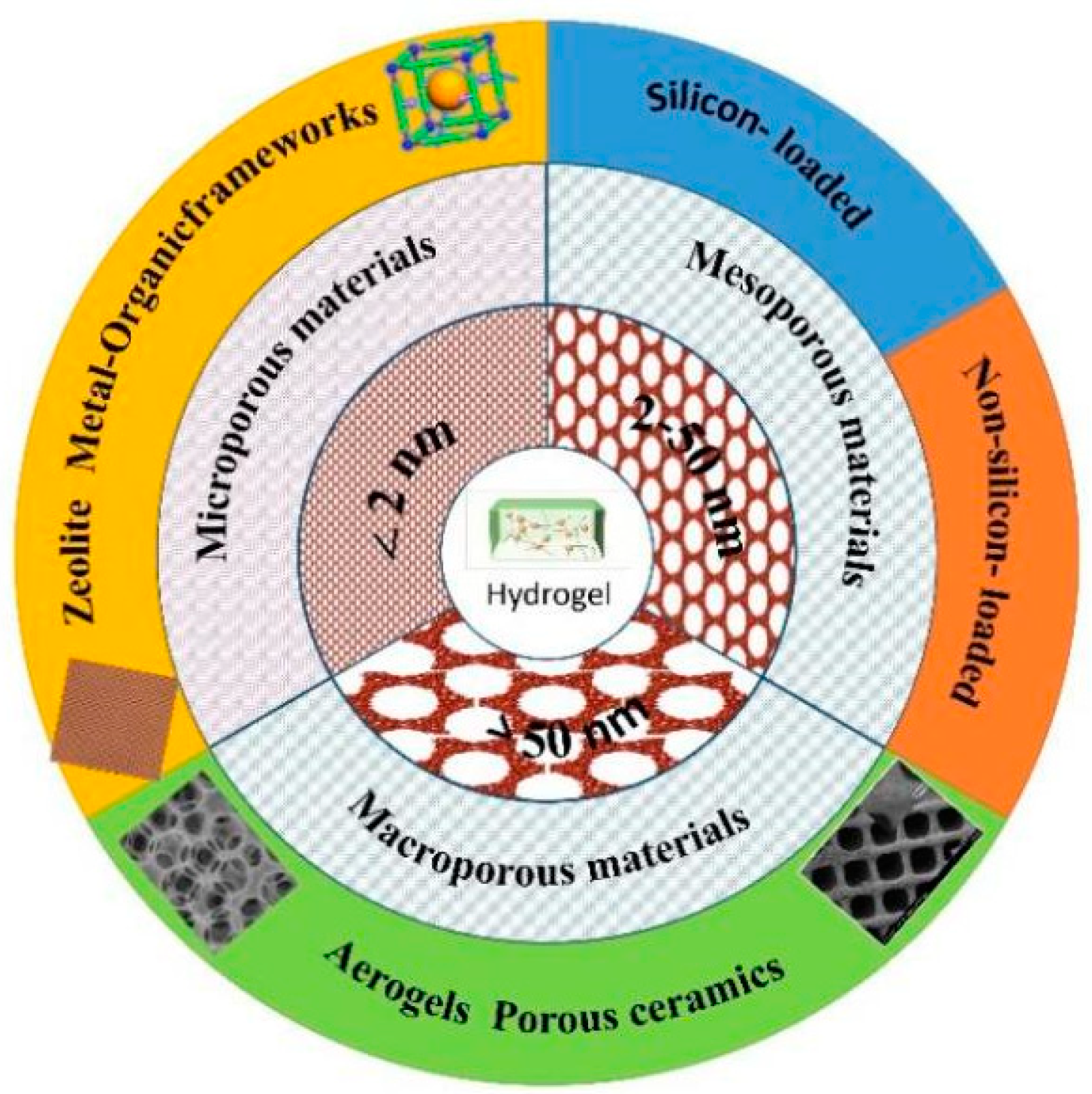
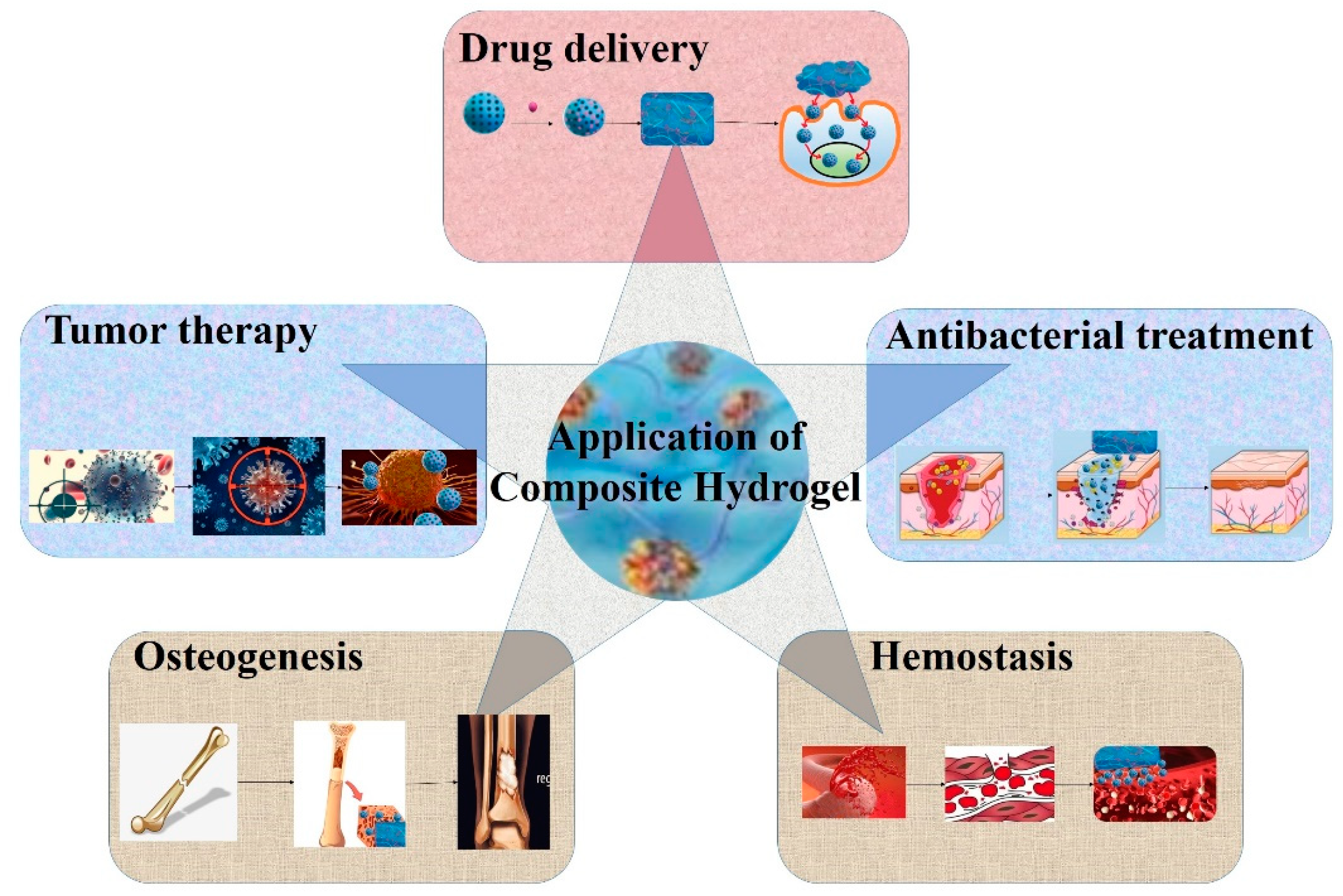
 ) and after swelling in the simulated uterine fluid for 30 days (
) and after swelling in the simulated uterine fluid for 30 days ( ), and other as-prepared PHEMA-based hydrogels [108].
), and other as-prepared PHEMA-based hydrogels [108].
 ) and after swelling in the simulated uterine fluid for 30 days (
) and after swelling in the simulated uterine fluid for 30 days ( ), and other as-prepared PHEMA-based hydrogels [108].
), and other as-prepared PHEMA-based hydrogels [108].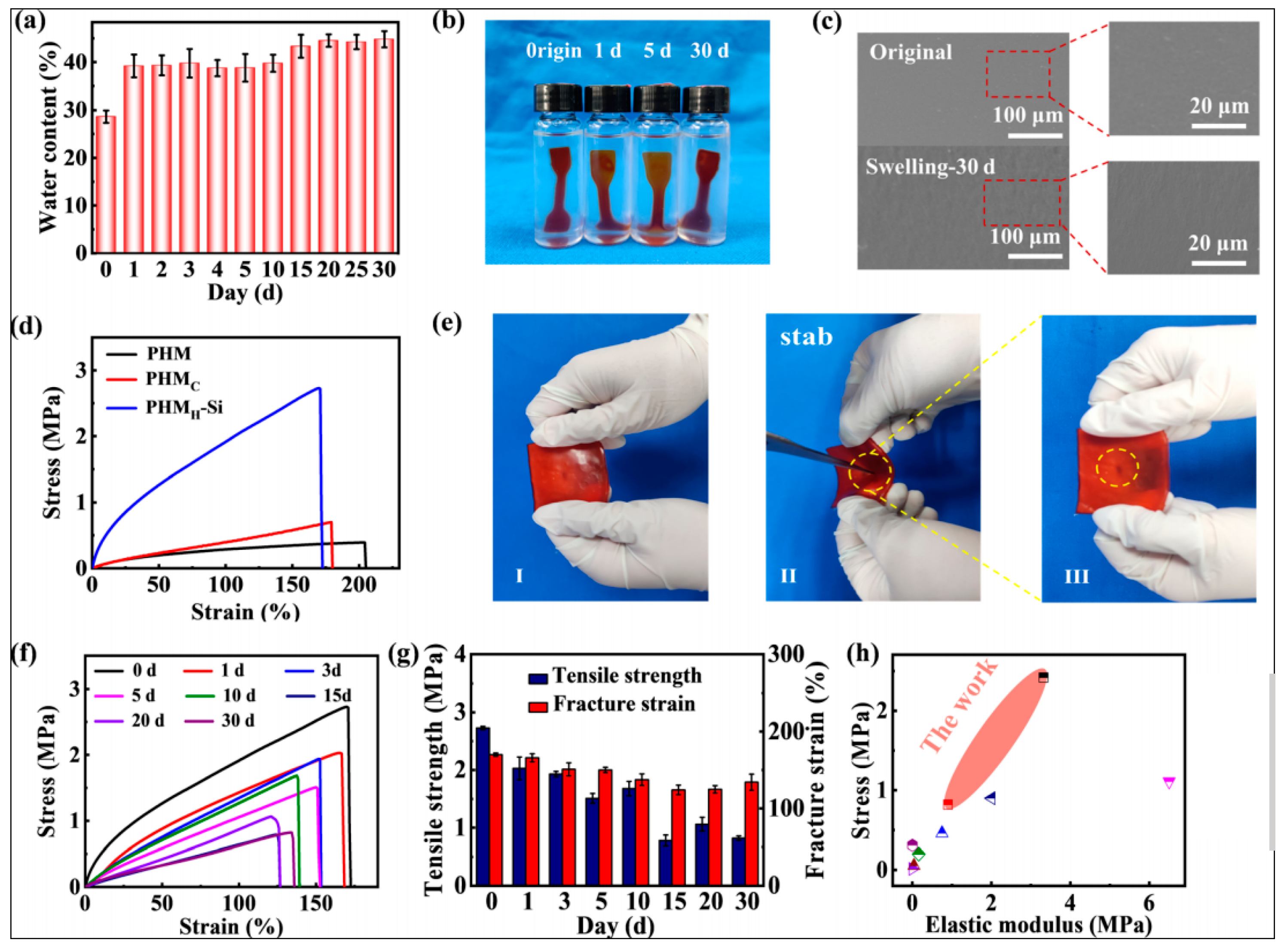
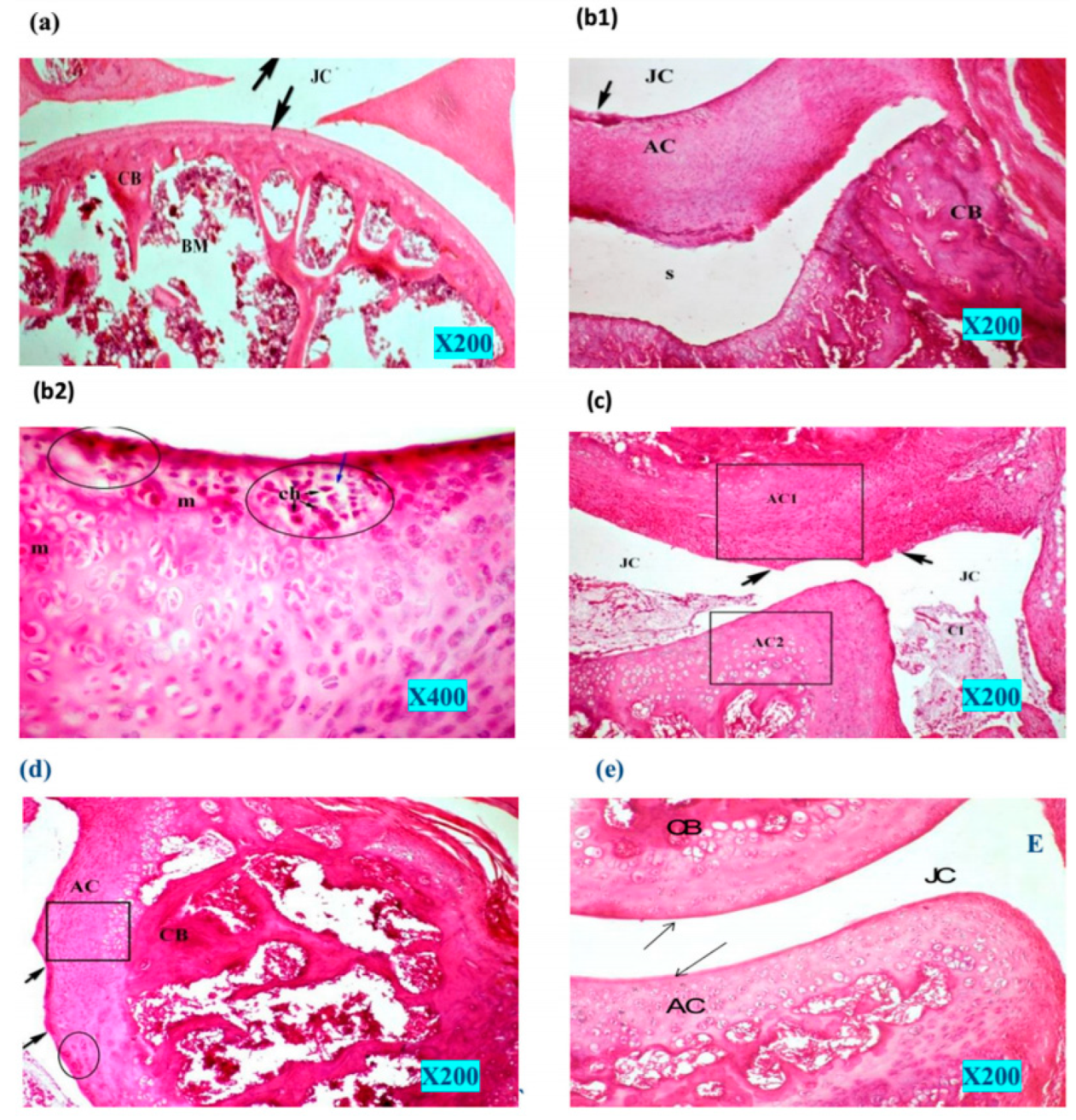
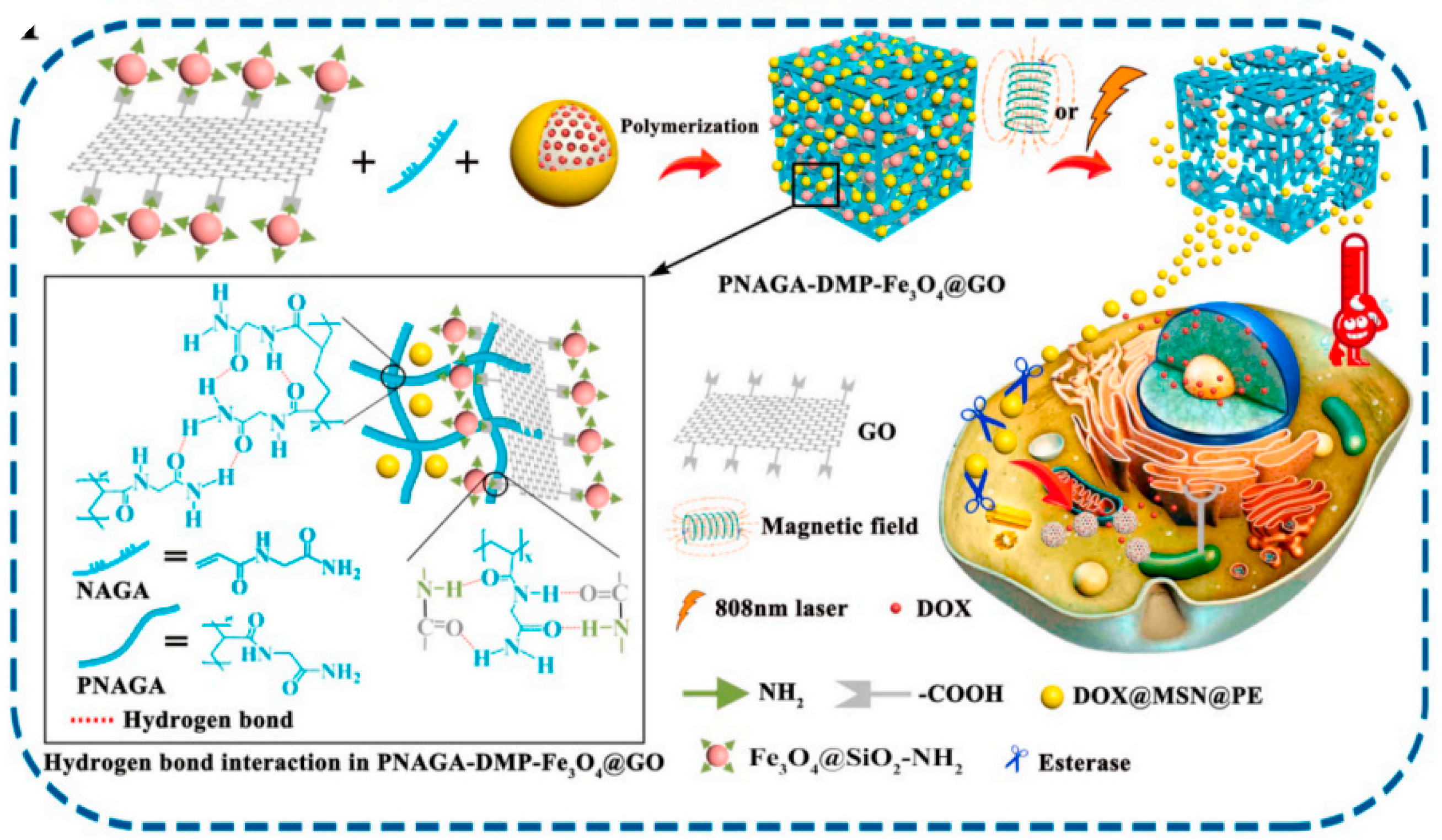

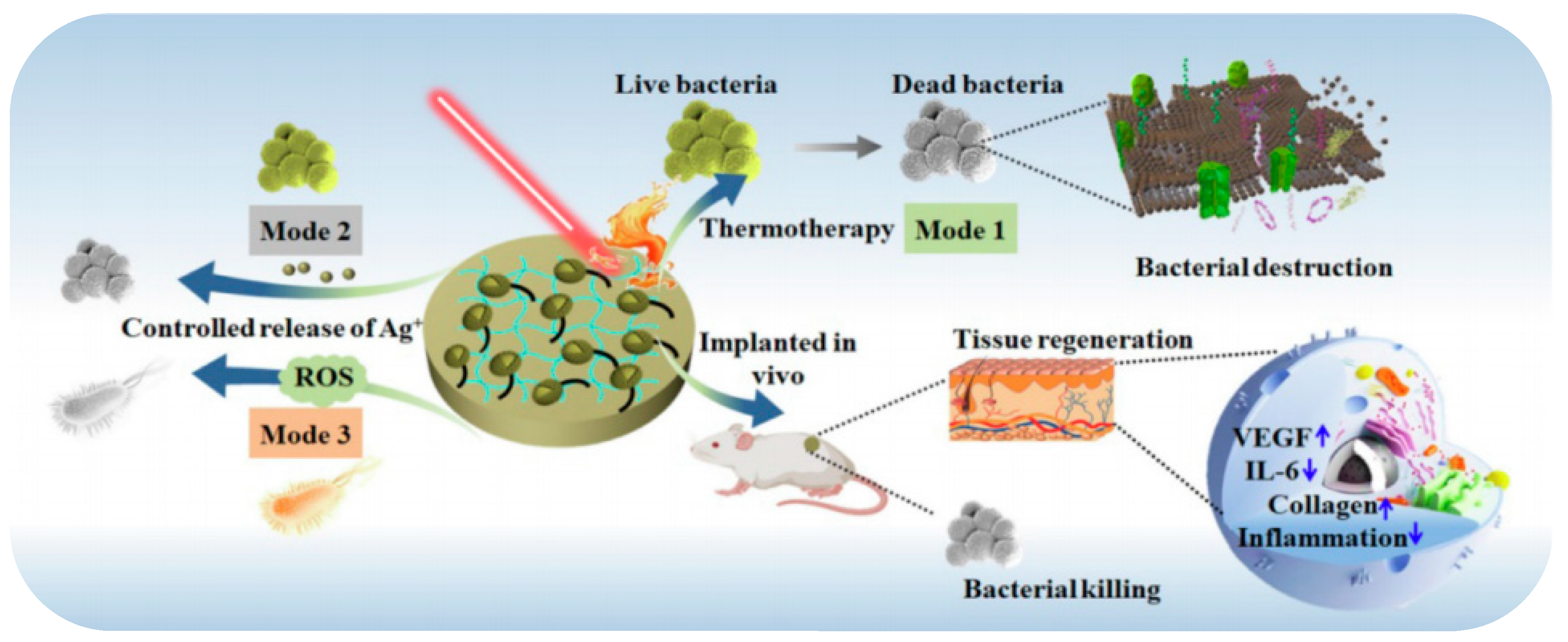
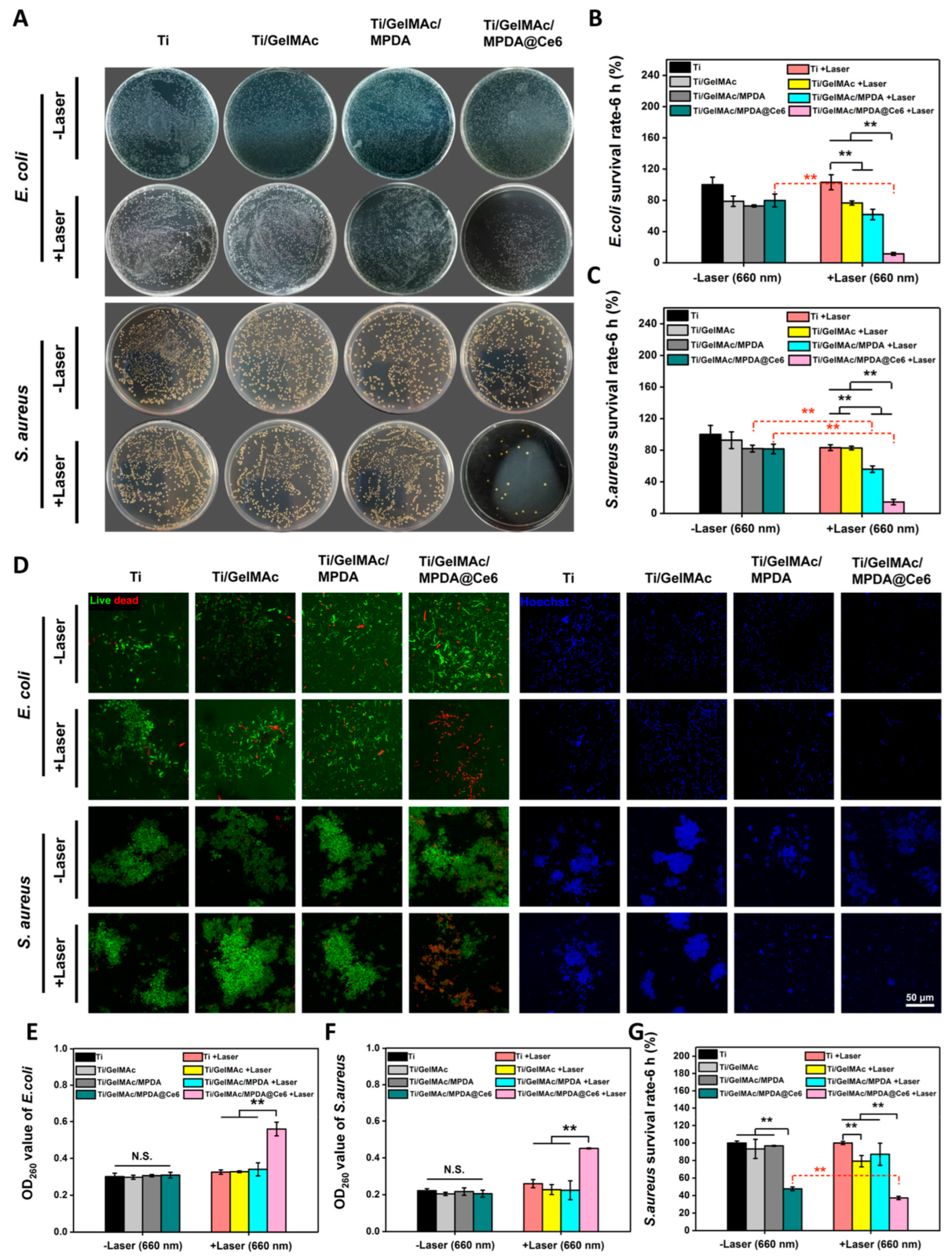

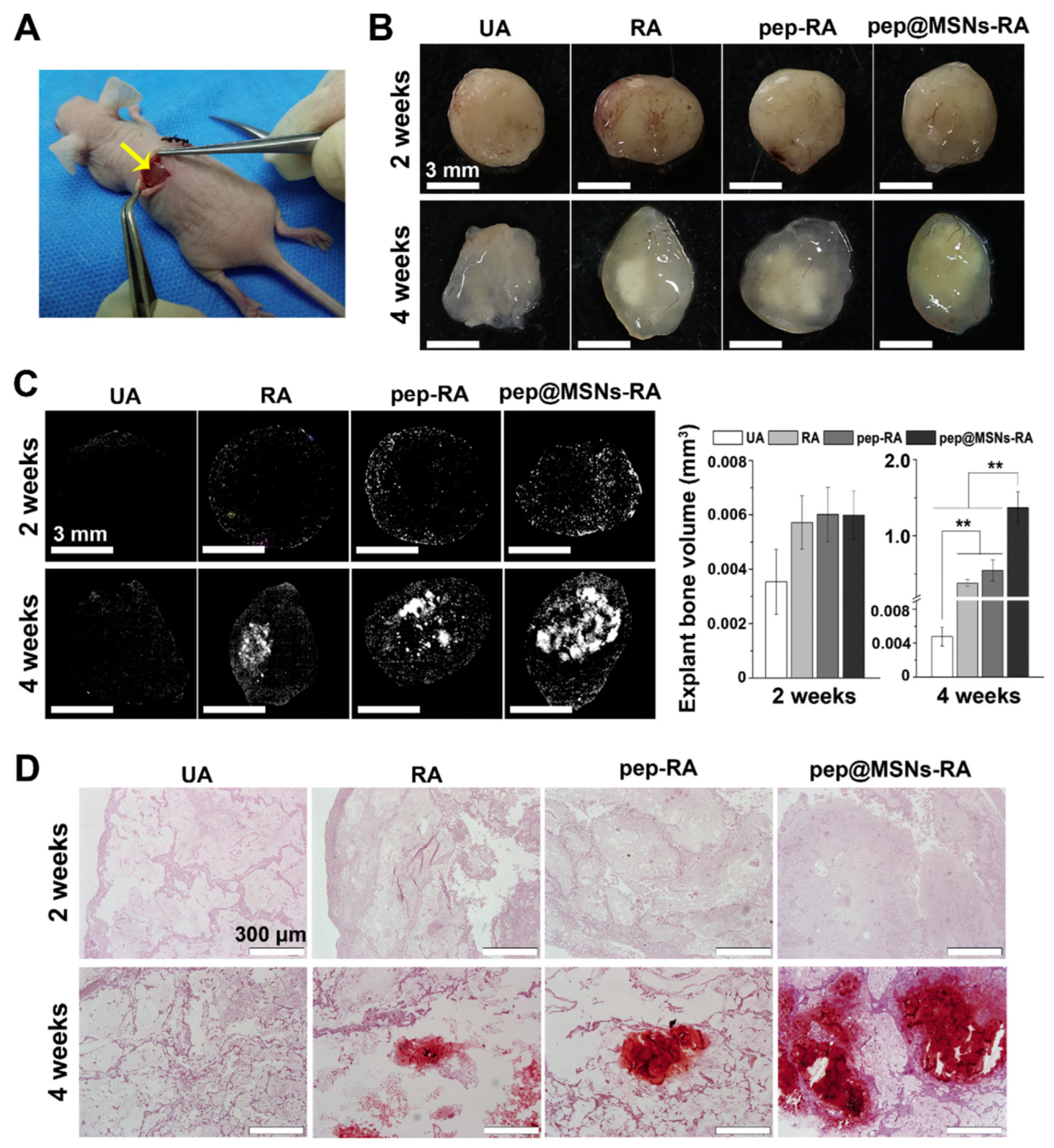
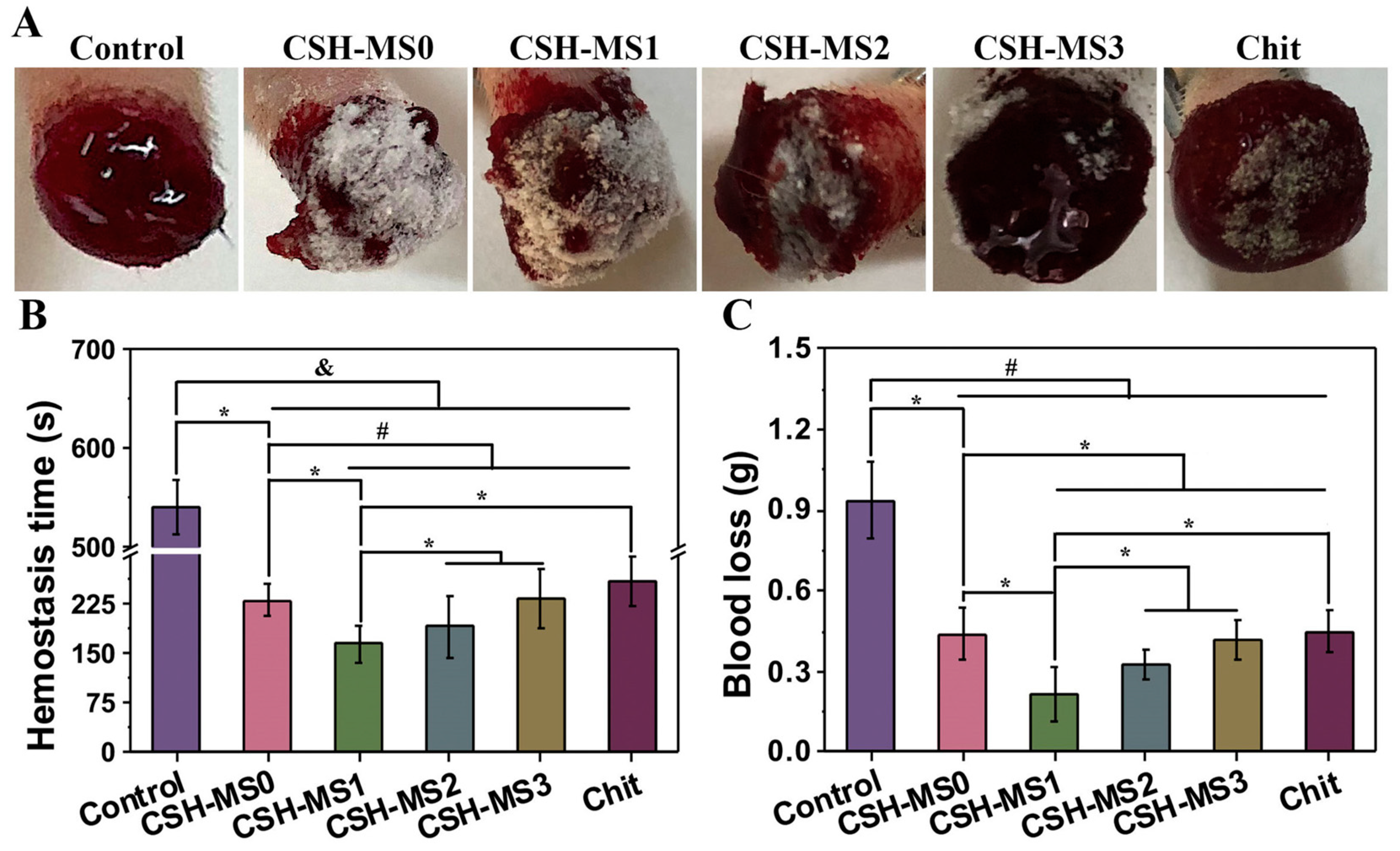
| Mesoporous Material | Chemical Composition | Hydrogel | Properties | Reference | |
|---|---|---|---|---|---|
| Silicon | Silica | MCM41 | Chitosan/Alginate | pH-sensitive and sustained release | [23] |
| MCM-41 | Poly(N-isopropylacrylamide) | Improved mechanical property | [24] | ||
| MCM-41 | Poly[(2-acryloyloxy)ethyl trimethylammonium chloride] | High water absorbency | [25] | ||
| MCM41,ZnO | Carboxymethyl cellulose | Great improvement in tensile strength, swelling, erosion, and gas permeability | [26] | ||
| Silica | SBA-15, SBA-16 | Alginate | Enhanced drug delivery | [27] | |
| SBA-15 | Poly[(N-isopropylacrylamide)-co-(mathacrylic acid)])(P[(N-iPAAm)-co-(MAA)]) | Thermo- and pH-sensitive | [28] | ||
| SBA-15 | Spruce xylan, 2-hydroxyethyl methacrylate | A potential scaffold for fibroblast growth and attachment | [29] | ||
| KIT-6 | Poly(N-isopropylacrylamide) | Thermo-responsive, controlled, and sustainable releases | [30] | ||
| Silica | Acrylamide | Target stimulus, magnetic | [31] | ||
| N-isopropylacrylamide, 2,2-dimethylaminoethyl methacrylate | Stimuli-responsive (pH, magnetic) | [32] | |||
| Polyvinyl alcohol | Inferior stability | [33] | |||
| Poly(N-isopropylacrylamide) | Thermo-responsive | [34] | |||
| N,N-dimethacrylamide | Temperature response | [35] | |||
| Polyamidoamines | Promoting mesenchymal stem cell migration | [36] | |||
| Polyacrylamide polydopamine | Enhance strength and adhesiveness to skin | [37] | |||
| Chitosan | pH- and electro-responsive | [38] | |||
| Gelatin methacryloyl | Improve stem cell adhesion | [39] | |||
| PEG-PCL-PEG | Near-infrared irradiation-controlled drug delivery | [40] | |||
| Silk fibroin, oxidized sodium carboxymethyl cellulose | pH- and redox-responsive bi-drug administration | [41] | |||
| Methacrylate gelatin /methacrylate hyaluronic acid | Sustained-release drug carrier | [42] | |||
| Chitosan | Sustained-delivery capability | [43] | |||
| Poly(ethylene glycol)-b-poly(lactic-co-glycolic acid)-b-poly(N-isopropylacrylamide) | Injectable thermo-responsive | [44] | |||
| chitosan | pH-responsive, magnetic | [45] | |||
| Organosilica | Alginate | Control cell growth and cell migration | [46] | ||
| Alginate | Control the enrichment of cells and simultaneous drug delivery | [47] | |||
| Bioglasses | Poly(ethylene oxide)-poly(propylene oxide)-poly(ethylene oxide) | Injectable thermosensitive | [48] | ||
| Biopolymer | Injectable strong adhesion and removability reusability | [49] | |||
| Modified hyaluronic acid | Injectable, long-term release | [50] | |||
| Chitosan-gelatin | Osteoinductivity capacity | [51] | |||
| Methylcellulose/polyvinyl Alcohol/polyvinylpyrrolidone | Injectable, thermo-sensitive | [52] | |||
| Pluronic F-127 | Thermosensitive behavior and injectability | [53] | |||
| Methacrylate gelatin | Better mechanical property, durable degradation time, pH stable, biomineralization, and long-term ion release | [54] | |||
| Silica-Calcia | Alginate dialdehyde-gelatin | Enhance osteoblast proliferation, adhesion, and differentiation | [55] | ||
| Alginate dialdehyde-gelatin | Induce bone regeneration, address infection | [56] | |||
| Non-silicon | Metal Oxides | TiO2 | Polyethyleneglycol diacrylate | Peritumoral injectability, localized and sustainable release, photochemistry effects | [57] |
| Poly(ethylene glycol) | High biocompatibility | [58] | |||
| Poly(ethylene glycol) | Yielded higher fluorescence signals and was more sensitive with lower detection | [59] | |||
| Alginate salt | Excellent photocatalytic functions | [60] | |||
| ZnO | Poly(2-hydroxyethyl methacrylate), poly(2-hydroxyethyl methacrylate)-co-poly(acrylic acid) | Mitigate undesirable burst-release effects | [61] | ||
| PCL-PEG-PCL | Drug carriers | [62] | |||
| MnO2 | Fenugreek gum, methylenebisacrylamide), acrylamide | Selective and effective adsorption of organic dyes | [63] | ||
| Poly(N-isopropylacrylamide-co-acrylic acid) | Thermal/pH-sensitive | [64] | |||
| Polydopamine | Cellulose nanofibrils | pH and near-infrared responsiveness | [65] | ||
| Gel | Injectable and biodegradable | [66] | |||
| Classification | Mesoporous Material | Hydrogel | Preparation Method | References |
|---|---|---|---|---|
| Physical crosslinking | Silica | Poly(d,l-lactide)-poly(ethylene glycol)-poly(d,l-lactide) | Simple mixture | [96] |
| Polydopamine | Cellulose nanofibril | Hydrogen bonding and π−π stacking interaction | [95] | |
| Silica | Polyacrylate | Ionic bonding and multiple hydrogen bonds | [97] | |
| Silica | Hyaluronic acid | Self-assemble hydrogen bonds | [98] | |
| Silica | Pineapple peel carboxymethyl cellulose, polyvinyl alcohol | Freeze–thaw | [99] | |
| Chemical crosslinking | Silica | 3-((2-(methacryloyloxy) ethyl) dimethylammonio) propane-1-sulfonate | Thiololefn click reaction | [100] |
| Silica | Aldehyde hyaluronic acid, N,O-carboxymethyl chitosan | Schiff base reaction | [78] | |
| Silica | Poly(ethylene glycol) diacrylate, [2-(Methacryloyloxy)ethyl] trimethylammonium chloride | Free-radical polymerization | [101] | |
| Silica | polyacrylamide | Hybridization chain reaction | [31] | |
| ZnO | Poly(2-hydroxyethyl methacrylate) Poly(HEMA-co-AA) | Initiator crosslinking method | [61] | |
| Silica | Methacrylate gelatin, methacrylate hyaluronic acid | Photo-initiated crosslinking method | [42] | |
| Radiation crosslinking | Silica | α-cyclodextrin, hyaluronic acid | Self-assemble (near-infrared radiation) | [102] |
| Bioglass | Methacrylate gelatin | Photo-crosslinked | [103] | |
| Titania | Polyethyleneglycol diacrylate | Photopolymerization under near-infrared radiation | [57] |
Disclaimer/Publisher’s Note: The statements, opinions and data contained in all publications are solely those of the individual author(s) and contributor(s) and not of MDPI and/or the editor(s). MDPI and/or the editor(s) disclaim responsibility for any injury to people or property resulting from any ideas, methods, instructions or products referred to in the content. |
© 2023 by the authors. Licensee MDPI, Basel, Switzerland. This article is an open access article distributed under the terms and conditions of the Creative Commons Attribution (CC BY) license (https://creativecommons.org/licenses/by/4.0/).
Share and Cite
Chen, H.; Qiu, X.; Xia, T.; Li, Q.; Wen, Z.; Huang, B.; Li, Y. Mesoporous Materials Make Hydrogels More Powerful in Biomedicine. Gels 2023, 9, 207. https://doi.org/10.3390/gels9030207
Chen H, Qiu X, Xia T, Li Q, Wen Z, Huang B, Li Y. Mesoporous Materials Make Hydrogels More Powerful in Biomedicine. Gels. 2023; 9(3):207. https://doi.org/10.3390/gels9030207
Chicago/Turabian StyleChen, Huangqin, Xin Qiu, Tian Xia, Qing Li, Zhehan Wen, Bin Huang, and Yuesheng Li. 2023. "Mesoporous Materials Make Hydrogels More Powerful in Biomedicine" Gels 9, no. 3: 207. https://doi.org/10.3390/gels9030207
APA StyleChen, H., Qiu, X., Xia, T., Li, Q., Wen, Z., Huang, B., & Li, Y. (2023). Mesoporous Materials Make Hydrogels More Powerful in Biomedicine. Gels, 9(3), 207. https://doi.org/10.3390/gels9030207





